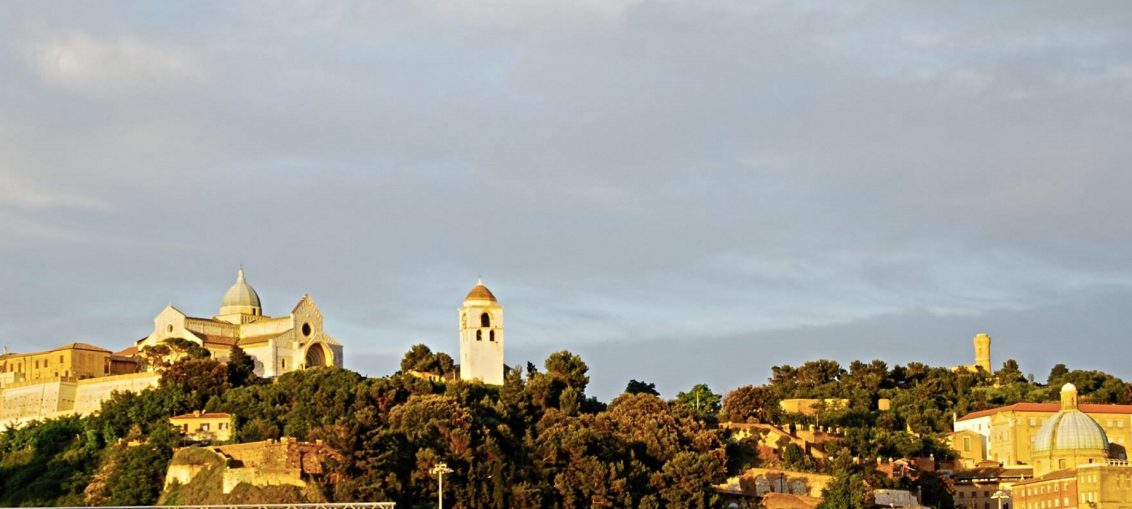
La Cattedrale di San Ciriaco rappresenta l’emblema di Ancona, sia per la posizione geografica sia per il significato storico e religioso. Collocata in una straordinaria posizione panoramica con il portale che abbraccia idealmente la città sottostante e il suo mare, è in stile romanico con influssi bizantini e gotici.
Il colle dove sorge si chiamava nell’antichità promontorio Cumero, nome composto dalle parole greche Kuma ed Oro, che insieme significano “monte opposto al mare”. In seguito fu chiamato colle di San Ciriaco o Colle Guasco, dal nome del colonnello Cesare Guasco che fece eseguire importanti fortificazioni verso il mare.
Sorge sull’antico tempio dedicato a Venere Euplea, protettrice della navigazione, di cui restano parte delle fondamenta. Su di esso, nel VI secolo d.C., venne costruita la basilica paleocristiana dedicata a San Lorenzo, che divenne Cattedrale nel 1000 quando vi furono traslati i corpi di San Ciriaco e San Marcellino. In quest’epoca l’edificio fu ampliato: fu costruito il braccio longitudinale che trasformò la pianta basilicale in croce greca, si alzò la cupola e sul nuovo braccio venne aperto l’accesso alla chiesa. La facciata è cuspide, tripartita, preceduta da un’ampia scalinata, alla cui sommità si innalza il protiro romanico-gotico, sorretto da colonne, due delle quali poggiano su leoni adagiati. Gli archi della strombatura hanno le fonti scolpite con motivi vegetali e figure umane che alludono al regno di Cristo nelle sue manifestazioni terrene e celesti. La torre campanaria è isolata e doveva appartenere al sistema difensivo che coronava la sommità del colle.
I resti del tempio pagano e della basilica paleocristiana sono ancora visibili sotto le lastre di vetro poste nel corpo centrale della cattedrale. Nell’ala sinistra si trova il monumento a Pietro Ghinelli, realizzato da Giovanni Dalmata da Traù nel 1509. Nell’ala sinistra, nella cappella della Madonna, si trova lo splendido altare di Luigi Vanvitelli (1738).
Cathedral of San Ciriaco
The Cathedral of San Ciriaco is the symbol of Ancona, both for its geographical position and for its historical and religious significance. Located in a panoramic position with the portal ideally embracing the city below and the sea, it is in the Romanesque style with Byzantine and gothic influences.
The hill on which the cathedral lies was once called Cumero, compound name from the Greek words Kuma and Oro, meaning “mountain facing the sea.”The hill was then called San Ciriaco or Guasco, in honour of the colonel Cesare Guasco who commissioned important fortifications.
The cathedral was built on an ancient temple dedicated to Venus Euplea, goddess of good navigation. A part of the foundations of the temple can still be seen today. In the sixth century AD, a basilica was built in place of the temple. It was dedicated to St. Lorenzo, and became a cathedral in year 1000 after the bodies of St. Ciriaco and St. Marcellino were moved here. At the same time, the building was expanded, with the addition of a perpendicular wing that transformed the plan of the basilica into a Greek cross, and the main entrance was moved to this new wing. At the same time the dome was raised. The facade is pointed, divided into three sections and with a wide staircase. The porch is in romanic-gothic style, held by columns, two of which rest on stone lions. The fronts of the splayed arches are sculpted with plant motifs and human figures alluding to the kingdom of Christ in its worldly and heavenly manifestations. The bell tower is isolated and must have been part of the defence walls of the hilltop.
The remains of the pagan temple and early Christian basilica are still visible beneath glass floors in the central part of the cathedral. In the left wing there is a monument to Pietro Ghinelli, built by Giovanni Dalmata from Trogir in 1509. In the same wing, in the chapel of the Virgin Mary, there is a beautiful altar by Luigi Vanvitelli (1738).
Kathedrale San Ciriaco
Die San Ciriaco Kathedrale ist das Symbol Anconas, sowohl wegen ihrer geographischen Lage als auch für ihre historische und religiöse Bedeutung. Die Kathedrale befindet sich auf einem Aussichtspunkt. Von daoben, kann man das Tor, die Stadt und das Meer sehen. Sie ist im romanischen Stil mit byzantinischen und gotischen Einflüssen gebaut.
Der Hügel, wo die Kathedrale liegt, wurde einst Cumero, genannt. Dieser Name ist ein Kompositum aus den griechischen Wörtern Kuma und Oro, das heißt “Berg aufs Meer”. Der Hügel wurde später San Ciriaco oder Guasco genannt, zu Ehren von dem Oberst Cesare Guasco, der die wichitigen Befestigungen bestellt hatte.
Die Kathedrale wurde auf einem alten Tempel gebaut und zu Venus Euplea, Göttin der guten Schiffahrt, gewidmet. Heute kann man noch die Ruine der Grundmauer des Tempels sehen. Im 6. Jahrhundert n.Chr, wurde eine Basilika anstatt des Tempels gebaut. Sie war zu St. Lorenzo gewidmet. Sie wurde im Jahr 1000 zu einer Kathedrale und danach wurden den Körpern von San Ciriaco und St. Marcellino dahin getragen und hingelegt. Gleichzeitlich wurde das Gebäude durch den Zusatz von einem senkrechten Flügel erweitert. Die Kirche ist deshalb nach einem griechischen Kreuz gebildet und der Haupteingang wurde zu diesem neuen Flügel verschoben. Daneben wurde die Kuppel erhöht. Die giebelförmige Fassade ist dreiteilig und ist über eine breite Treppe verfügt. Die romanische gotische Laube unterstützen die Säulen. Von denen, zwei lehnen auf steinernen Löwen. Die Gewände der Bögen sind mit Pflanzenmotiven und menschliche Figuren verziert die das Reich Christi in seiner weltichen und himmlischen Erscheinungen darstellen. Der Glockenturm ist getrennt, und sollte zu den Wehrmauern des Hügels gehören.
Die Ruinen des heidnischen Tempels und der frühchristlichen Basilika sind noch unter dem Glasboden (in der Mitte des Doms) zu sehen. Im linken Flügel befindet sich ein Denkmal zu Ehren Pietro Ghinellis. Es wurde 1509 von Giovanni Dalmata von Trogir eingemeißelt. Im linken Flügel, innerhalb der Kapelle der Madonna, gibt es einen schönen Altar von Luigi Vanvitelli (1738).
